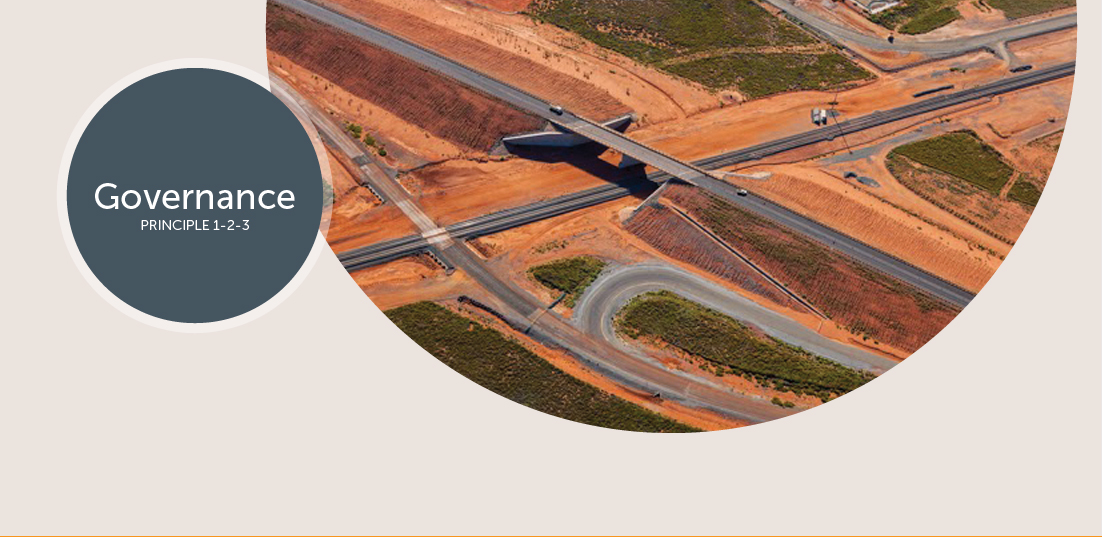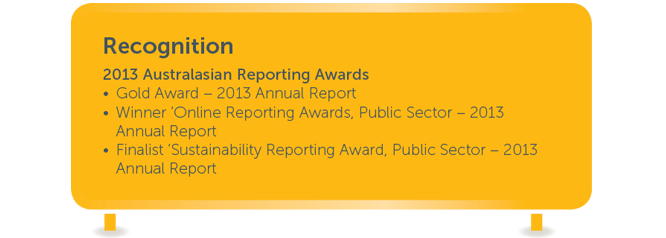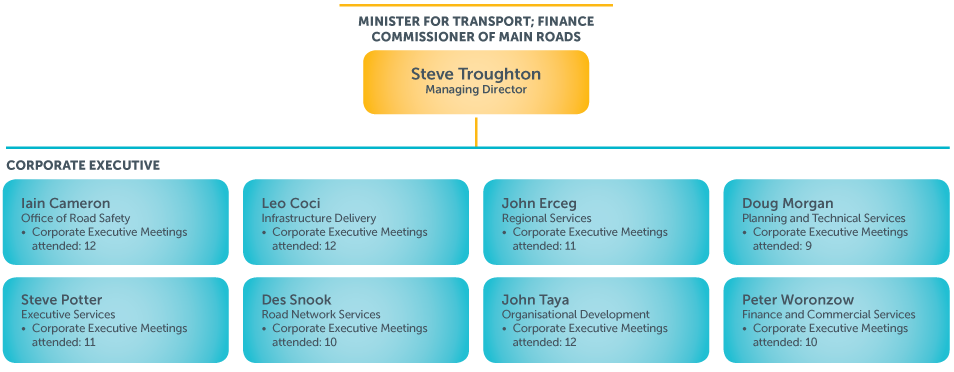Principle 1: Government and Public Sector Relationship
Our Governance Model
Our corporate governance system is how we direct and manage our business activities to optimise performance, achieve regulatory compliance and deliver value for customers. We ensure our core corporate governance system and processes are aligned with values-driven management. The framework enables us to govern with integrity, accountability and transparency. Our Governance Model and Structure can be found below and shows the relationships between our Minister, Commissioner, Managing Director and members of Corporate Executive.
Performance Agreement
The Managing Director has a performance agreement with the Commissioner while other members of Corporate Executive have Individual Performance Agreements with the Managing Director.
Empowering Legislation
Main Roads Act
The Main Roads Act 1930, as last amended in 1996, establishes the Commissioner of Main Roads as a corporate body and sets out the powers and duties of the office.
The Commissioner of Main Roads administers the Main Roads Act and the accompanying Regulations and is accountable to the Minister for Transport.
The Office of Road Safety Empowering Legislation
The Road Safety Council Act 2002 is the enabling legislation for the Office of Road Safety.
Governance is supported with the Road Safety Council Governance Charter, the Road Safety Council Code of Conduct and the Office of Road Safety Role Statement approved by the Minister.
Other Empowering Legislation
- The Land Administration Act 1997 provides powers for the resumption of land
- Section 84 of the Road Traffic Act 1974 provides a right of recovery for road damage
- Regulation 297 of the Road Traffic Code 2000 provides the Commissioner with the power to erect road signs and traffic signals, and install road marking
- Part 4 of the Road Traffic (Vehicle Standards) Regulations 2002 provides the Commissioner with the authority to issue permits for restricted access vehicles that exceed certain mass and dimension limits, as defined in the Regulations.
We have processes and controls in place to ensure that we comply with other State and Commonwealth legislation and regulations which impact on our activities. Ministerial Directives There were no directives issued by the Minister for Transport under Section 19B of the Main Roads Act 1930 during the year.
Principle 2 & 3: Management and Oversight and Organisational Structure
Strategic Plan
In August 2013 we released our new Strategic Plan known as 2020. Our 2020 Strategy describes the strategic direction that we will take over the next six years and represents our response to the challenges, opportunities and environment that we work in. Our integrated approach to planning is based on input from partners, stakeholders, customers and employees and is coordinated through our Strategic Plan. Importantly 2020 is also integrated with the Government’s goals and vision for the public sector in providing services to the community.
In developing our new plan we have used scenario planning to capture a variety of economic, social, political and technological trends that have the potential to impact on our business. We have created a new Vision and, Purpose and identified five areas of focus to guide us in the coming years.
Further information on our Strategic Plan is available on our website. We discuss how our Corporate Business Plan keeps track and measures our performance in alignment with our Strategic Plan in Principle 4.
Delegation of Authority
Our Delegation of Authority Manual exists to clearly define the administrative responsibilities of officers and give them sufficient authority to carry out their day-to-day tasks. The Delegation of Authority is in accordance with the Main Roads Act 1930 and the principle of public administration set out in Section 7(d) of the Public Sector Management Act 1994. Employees are aware that delegation limits are specified in the Delegation of Authority Manual and that they must not be exceeded.
Corporate Executive
Corporate Executive’s Objectives:
Set clear strategic direction to deliver government priorities, meet our purpose and achieve defined performance goals.
Corporate Executive’s Role:
- Assist in discharging the Managing Director’s responsibilities and to operate as an advisory body to the Managing Director
- Achieve the best outcomes from key decisions, develop executive commitment to key organisational priorities and model Main Roads’ values and behaviours to the organisation
- Set strategy, oversight, decision-making and leadership and manage organisational performance to ensure capability to deliver road user services
- Provide a forum to raise issues of corporate relevance and seek the feedback and input from peers
- Be proactive, orientated to the long term and outcomes focused.
Standing Committees
- Management Review and Audit
- Corporate Development
- Business Improvement
- Budget
- Safety, Health and Wellbeing
The following is a summary of the membership and achievements for each committee.
Standing Committees Role and Achievements
| Corporate Development Committee Meetings Held: 7 | ||
| Membership (Attendance) | Role | Achievements |
|---|---|---|
|
Executive Members: John Taya (Chair) – 6 John Erceg –3 Des Snook – 3 Leo Coci – 6 Peter Woronzow – 1 Doug Morgan – 4 There are 2 other non – executive standing members in this committee |
|
|
| Business Improvement Committee Meetings Held: 3 | ||
| Membership (Attendance) | Role | Achievements |
|---|---|---|
|
Executive Members: Peter Woronzow (Chair) – 3 John Erceg – 1 John Taya – 0 Doug Morgan – 0 There are 3 other non-executive standing members in this committee |
|
|
| Management Review and Audit Committee Meetings Held: 3 | ||
| Membership (Attendance) | Role | Achievements |
|---|---|---|
|
Executive Members: Steve Troughton (Chair) – 3 Peter Woronzow – 3 Doug Morgan – 2 |
|
|
| Budget Committee Meetings Held: 12 | ||
| Membership (Attendance) | Role | Achievements |
|---|---|---|
|
Executive Members: Peter Woronzow (Chair) – 10 Steve Troughton – 10 John Erceg – 7 Des Snook – 7 Leo Coci – 11 Doug Morgan – 7 John Taya – 9 |
|
|
| Safety, Health and Wellbeing Committee Meetings Held: 11 | ||
| Membership (Attendance) | Role | Achievements |
|---|---|---|
|
Executive Members: Doug Morgan (Chair) – 9 John Erceg – 6 Des Snook – 1 Leo Coci – 9 Peter Woronzow – 2 John Taya – 9 Iain Cameron – 1 There are 10 other non-executive standing members in this committee. |
|
|




